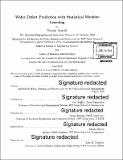| dc.contributor.advisor | Roy Welsch and Duane Boning. | en_US |
| dc.contributor.author | Arnold, Naomi (Naomi Aiko) | en_US |
| dc.contributor.other | Leaders for Global Operations Program. | en_US |
| dc.date.accessioned | 2016-12-05T19:55:48Z | |
| dc.date.available | 2016-12-05T19:55:48Z | |
| dc.date.copyright | 2016 | en_US |
| dc.date.issued | 2016 | en_US |
| dc.identifier.uri | http://hdl.handle.net/1721.1/105633 | |
| dc.description | Thesis: S.M. in Engineering Systems, Massachusetts Institute of Technology, School of Engineering, Institute for Data, Systems, and Society, 2016. In conjunction with the Leaders for Global Operations Program at MIT. | en_US |
| dc.description | Thesis: M.B.A., Massachusetts Institute of Technology, Sloan School of Management, 2016. In conjunction with the Leaders for Global Operations Program at MIT. | en_US |
| dc.description | Cataloged from PDF version of thesis. | en_US |
| dc.description | Includes bibliographical references (pages 81-83). | en_US |
| dc.description.abstract | In the semiconductor industry where the technology continues to grow in complexity while also striving to achieve lower manufacturing costs, it is becoming increasingly important to drive cost savings by screening out defective die upstream. The primary goal of the project is to build a statistical prediction model to facilitate operational improvements across two global manufacturing locations. The scope of the project includes one high-volume product line, an off-line statistical model using historical production data, and experimentation with machine learning algorithms. The prediction model pilot demonstrates there exists a potential to improve the wafer sort process using random forest classifier on wafer and die-level datasets. Yet more development is needed to conclude final memory test defect die-level predictions are possible. Key findings include the importance of model computational performance in big data problems, necessity of a living model that stays accurate over time to meet operational needs, and an evaluation methodology based on business requirements. This project provides a case study for a high-level strategy of assessing big data and advanced analytics applications to improve semiconductor manufacturing. | en_US |
| dc.description.statementofresponsibility | by Naomi Arnold. | en_US |
| dc.format.extent | 83 pages | en_US |
| dc.language.iso | eng | en_US |
| dc.publisher | Massachusetts Institute of Technology | en_US |
| dc.rights | M.I.T. theses are protected by copyright. They may be viewed from this source for any purpose, but reproduction or distribution in any format is prohibited without written permission. See provided URL for inquiries about permission. | en_US |
| dc.rights.uri | http://dspace.mit.edu/handle/1721.1/7582 | en_US |
| dc.subject | Institute for Data, Systems, and Society. | en_US |
| dc.subject | Sloan School of Management. | en_US |
| dc.subject | Engineering Systems Division. | en_US |
| dc.subject | Leaders for Global Operations Program. | en_US |
| dc.title | Wafer defect prediction with statistical machine learning | en_US |
| dc.type | Thesis | en_US |
| dc.description.degree | S.M. in Engineering Systems | en_US |
| dc.description.degree | M.B.A. | en_US |
| dc.contributor.department | Leaders for Global Operations Program at MIT | en_US |
| dc.contributor.department | Massachusetts Institute of Technology. Engineering Systems Division | |
| dc.contributor.department | Massachusetts Institute of Technology. Institute for Data, Systems, and Society | |
| dc.contributor.department | Sloan School of Management | |
| dc.identifier.oclc | 963214425 | en_US |
